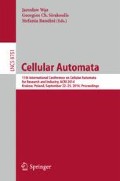Abstract
The knowledge of phenomena connected with pedestrian movement and behavior is important in retail and service sectors. Such a belief finds confirmation in numerous researches, which proved true a strong relationship between shops’ profitability and the way customers move inside them. The goal of the article is to work out a model of pedestrian behavior in a shopping mall based on a multi-agent approach on the basis of some already-existing successful solutions, namely we combine PED4 and Social Distances algorithms into one simulation framework.
Access this chapter
Tax calculation will be finalised at checkout
Purchases are for personal use only
Preview
Unable to display preview. Download preview PDF.
References
Borgers, A., Timmermans, H.J.P.: A Model of Pedestrian Route Choice and Demand for Retail Facilities within Inner-City Shopping Areas. Geographical Analysis (1986)
Dijkstra, J., Timmermans, H.J.P., de Vries, B.: Modeling impulse and non-impulse store choice processes in a multi-agent simulation of pedestrian activity in shopping environments. In: Timmermans, H.J.P. (ed.) Pedestrian Behavior Models: Data Collection and Applications, pp. 63–87. Emerald, Bingley (2009)
Bandini, S., Manzoni, S., Vizzari, G.: Agent-based Modeling and simulation. In: Meyers, R.A. (ed.) Computational Complexity, pp. 105–117. Springer, New York (2012)
Bandini, S., Mondini, M., Vizzari, G.: Modelling negative interactions among pedestrians in high density situations. Transportation Research Part C: Emerging Technologies 40, 251–270 (2014)
Rauh, J., Schenk, T., Schödl, D.: The Simulated consumer - an agent-based approach to shopping behaviour (2011)
Blue, V., Adler, J.: Modelling Four Directional Pedestrian Movements (2000)
Wąs, J., Gudowski, B., Matuszyk, P.: Social Distances Model of Pedestrian Dynamics (2006)
Wąs, J., Lubaś, R.: Adapting Social Distances Model for Mass Evacuation Simulation. Journal of Cellular Automata 8(5-6), 395–405 (2013)
Wąs, J., Lubaś, R.: Towards realistic and effective Agent-based models of crowd dynamics. Neurocomputing (accepted)
Blue, V., Adler, J.: Cellular automata microsimulation for modeling bi-directional pedestrian walkways (2001)
Bitgood, S., Dukes, S.: Economy of Movement and Pedestrian Choice Point Behavior in Shopping Malls (2005)
Bandini, S., Gorrini, A., Vizzari, G.: Towards an integrated approach to crowd analysis and crowd synthesis: A case study and first results. Pattern Recognition Letters 44, 16–29 (2014)
Author information
Authors and Affiliations
Editor information
Editors and Affiliations
Rights and permissions
Copyright information
© 2014 Springer International Publishing Switzerland
About this paper
Cite this paper
Kłeczek, P., Wąs, J. (2014). Simulation of Pedestrians Behavior in a Shopping Mall. In: Wąs, J., Sirakoulis, G.C., Bandini, S. (eds) Cellular Automata. ACRI 2014. Lecture Notes in Computer Science, vol 8751. Springer, Cham. https://doi.org/10.1007/978-3-319-11520-7_69
Download citation
DOI: https://doi.org/10.1007/978-3-319-11520-7_69
Publisher Name: Springer, Cham
Print ISBN: 978-3-319-11519-1
Online ISBN: 978-3-319-11520-7
eBook Packages: Computer ScienceComputer Science (R0)

